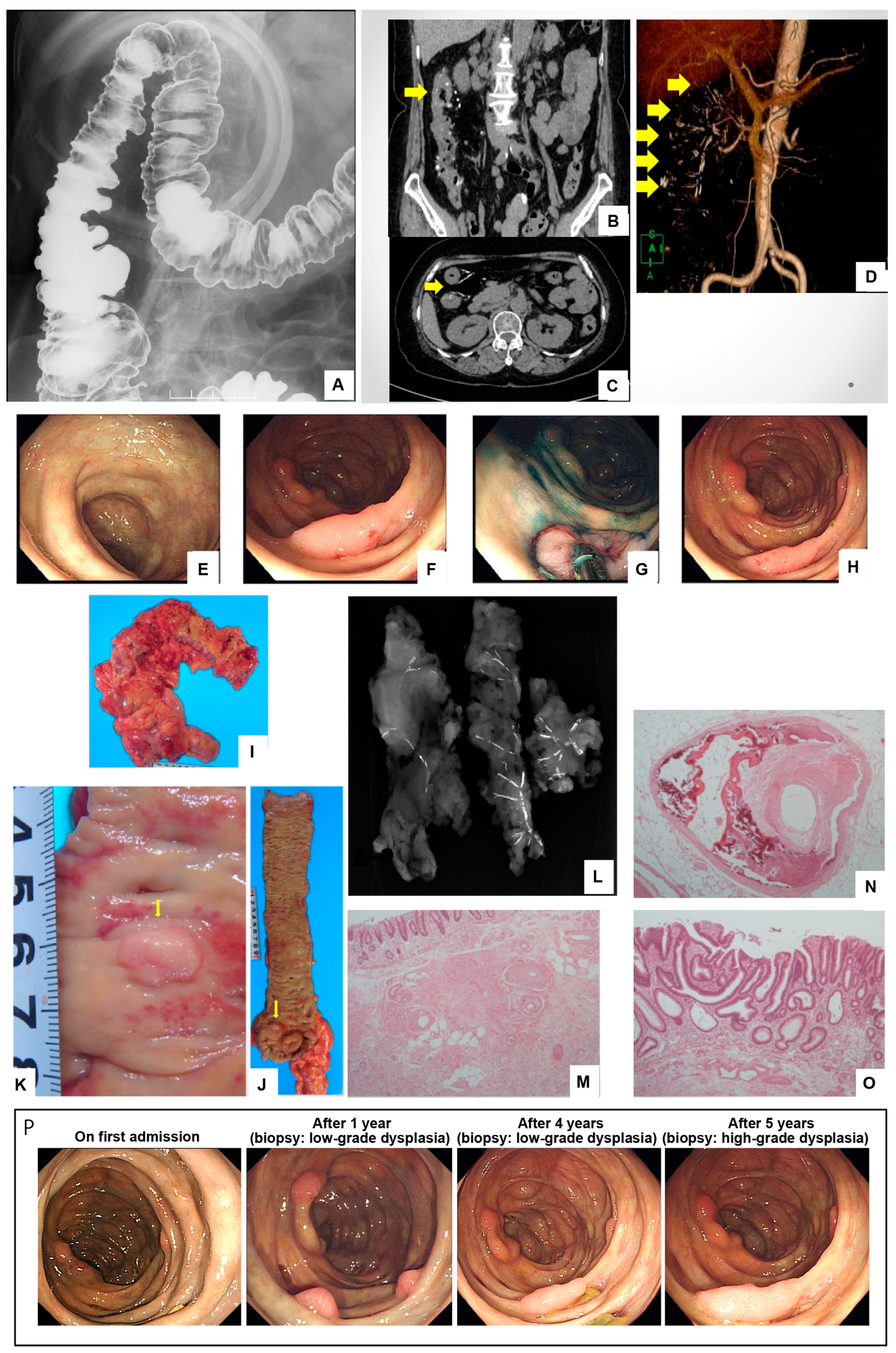Hangeshashinto-Associated Mesenteric Phlebosclerosis and Highly Atypical Adenoma Requiring Laparoscopic Right Hemicolectomy
Abstract

Author Contributions
Funding
Institutional Review Board Statement
Informed Consent Statement
Data Availability Statement
Conflicts of Interest
References
- Winawer, S.J.; Zauber, A.G. The advanced adenoma as the primary target of screening. Gastrointest. Endosc. Clin. N. Am. 2002, 12, 1–9. [Google Scholar] [CrossRef] [PubMed]
- Iwashita, A.; Yao, T.; Schlemper, R.J.; Kuwano, Y.; Yao, T.; Iida, M.; Matsumoto, T.; Kikuchi, M. Mesenteric phlebosclerosis: A new disease entity causing ischemic colitis. Dis. Colon. Rectum 2003, 46, 209–220. [Google Scholar] [CrossRef] [PubMed]
- Koyama, N.; Koyama, H.; Hanajima, T.; Honma, M.; Matsubara, N. Chronic ischemic colitis causing stenosis: Report of a case. Stom Intest. 1991, 26, 455–460. [Google Scholar]
- Wang, J.; Shao, J.; Lu, H.; Wang, B.; Chen, J. Idiopathic mesenteric phlebosclerosis: One case report and systematic literature review of 240 cases. Am. J. Transl. Res. 2021, 13, 13156–13166. [Google Scholar] [PubMed]
- Shimizu, S.; Kobayashi, T.; Tomioka, H.; Ohtsu, K.; Matsui, T.; Hibi, T. Involvement of herbal medicine as a cause of mesenteric phlebosclerosis: Results from a large-scale nationwide survey. J. Gastroenterol. 2017, 52, 308–314. [Google Scholar] [CrossRef] [PubMed]
- Shimada, Y.; Fujimoto, M.; Nogami, T.; Watari, H. Adverse Events Associated with Ethical Kampo Formulations: Analysis of the Domestic Adverse-Event Data Reports of the Ministry of Health, Labor, and Welfare in Japan. Evid. Based Complement. Alternat Med. 2019, 2019, 1643804. [Google Scholar] [CrossRef]
- Nagata, Y.; Watanabe, T.; Nagasaka, K.; Yamada, M.; Murai, M.; Takeuchi, S.; Murase, M.; Yazaki, T.; Murase, T.; Komatsu, K.; et al. Total dosage of gardenia fruit used by patients with mesenteric phlebosclerosis. BMC Complement. Altern. Med. 2016, 16, 207. [Google Scholar] [CrossRef] [PubMed]
- Ohtsu, K.; Matsui, T.; Nishimura, T.; Hirai, F.; Ikeda, K.; Iwashita, A.; Yorioka, M.; Hatakeyama, S.; Hoashi, T.; Koga, Y.; et al. Association between mesenteric phlebosclerosis and Chinese herbal medicine intake. Jpn. J. Gastro-Enterol. 2014, 111, 61–68. [Google Scholar]
- Walle, T. Absorption and metabolism of flavonoids. Free Radic. Biol. Med. 2004, 36, 829–837. [Google Scholar] [CrossRef] [PubMed]
- Nakazawa, K.; Shingaki, N.; Maekita, T.; Enomoto, S.; Mori, Y.; Oota, U.; Bunno, M.; Ichinose, M. A case of idiopathic mesenteric phlebosclerosis that was successfully treated with the cobination therapy of warfarin and aspirin. Gastroenterol. Endosc. 2019, 58, 2169–2175. [Google Scholar]
- Kohga, K.; Miki, K.; Nagata, K.; Kohga, S.; Uemura, A.; Oze, T.; Shinzaki, S.; Nishida, T.; Iijima, H.; Tsuji, M. A case of idiopathic mesenteric phlebosclerosis treated with mesalazine. Gastroenterol. Endosc. 2011, 53, 3548–3554. [Google Scholar]
- Shimizu, S. Mesenteric phlebosclerosis. Nippon. Daicho Komonbyo Gakkai Zasshi 2021, 74, 606–612. [Google Scholar] [CrossRef]
- Saito, Y.; Yamada, M.; So, E.; Abe, S.; Sakamoto, T.; Nakajima, T.; Otake, Y.; Ono, A.; Matsuda, T. Colorectal endoscopic submucosal dissection: Technical advantages compared to endoscopic mucosal resection and minimally invasive surgery. Dig. Endosc. 2014, 26 (Suppl. 1), 52–61. [Google Scholar] [CrossRef] [PubMed]
- Kawasaki, K.; Eizuka, M.; Kudara, N.; Yanai, S.; Toya, Y.; Torisu, T.; Umeno, J.; Nakamura, S.; Sugai, T.; Matsumoto, T. Mesenteric phlebosclerosis complicating colonic cancer treated by endoscopic submucosal dissection. Clin. J. Gastroenterol. 2020, 13, 1183–1188. [Google Scholar] [CrossRef] [PubMed]
- Satake, R.; Tokuhara, K.; Hashimoto, Y.; Yamamichi, K.; Yoshioka, K.; Sekimoto, M. A case of early ascending colon cancer complicated the mesenteric phlebosclerosis who underwent laparoscopic subtotal colectomy. Gan To Kagaku Ryoho. 2022, 49, 306–308. (In Japanese) [Google Scholar] [PubMed]
- Hiramatsu, K.; Sakata, H.; Horita, Y.; Orita, N.; Kida, A.; Mizukami, A.; Miyazawa, M.; Hirai, S.; Shimatani, A.; Matsuda, K.; et al. Mesenteric phlebosclerosis associated with long-term oral intake of geniposide, an ingredient of herbal medicine. Aliment. Pharmacol. Ther. 2012, 36, 575–586. [Google Scholar] [CrossRef] [PubMed]
Disclaimer/Publisher’s Note: The statements, opinions and data contained in all publications are solely those of the individual author(s) and contributor(s) and not of MDPI and/or the editor(s). MDPI and/or the editor(s) disclaim responsibility for any injury to people or property resulting from any ideas, methods, instructions or products referred to in the content. |
© 2024 by the authors. Licensee MDPI, Basel, Switzerland. This article is an open access article distributed under the terms and conditions of the Creative Commons Attribution (CC BY) license (https://creativecommons.org/licenses/by/4.0/).
Share and Cite
Nishiwaki, R.; Inoue, Y.; Sugao, M.; Sugimasa, N.; Hamaguchi, T.; Noji, M.; Takeuchi, K.; Ito, Y.; Kato, T.; Yasuma, T.; et al. Hangeshashinto-Associated Mesenteric Phlebosclerosis and Highly Atypical Adenoma Requiring Laparoscopic Right Hemicolectomy. Diagnostics 2024, 14, 565. https://doi.org/10.3390/diagnostics14050565
Nishiwaki R, Inoue Y, Sugao M, Sugimasa N, Hamaguchi T, Noji M, Takeuchi K, Ito Y, Kato T, Yasuma T, et al. Hangeshashinto-Associated Mesenteric Phlebosclerosis and Highly Atypical Adenoma Requiring Laparoscopic Right Hemicolectomy. Diagnostics. 2024; 14(5):565. https://doi.org/10.3390/diagnostics14050565
Chicago/Turabian StyleNishiwaki, Ryo, Yasuhiro Inoue, Masataka Sugao, Natsuko Sugimasa, Tetsuya Hamaguchi, Midori Noji, Kenji Takeuchi, Yoshiyuki Ito, Toshio Kato, Taro Yasuma, and et al. 2024. "Hangeshashinto-Associated Mesenteric Phlebosclerosis and Highly Atypical Adenoma Requiring Laparoscopic Right Hemicolectomy" Diagnostics 14, no. 5: 565. https://doi.org/10.3390/diagnostics14050565
APA StyleNishiwaki, R., Inoue, Y., Sugao, M., Sugimasa, N., Hamaguchi, T., Noji, M., Takeuchi, K., Ito, Y., Kato, T., Yasuma, T., D’Alessandoro-Gabazza, C. N., Gabazza, E. C., & Imoto, I. (2024). Hangeshashinto-Associated Mesenteric Phlebosclerosis and Highly Atypical Adenoma Requiring Laparoscopic Right Hemicolectomy. Diagnostics, 14(5), 565. https://doi.org/10.3390/diagnostics14050565






